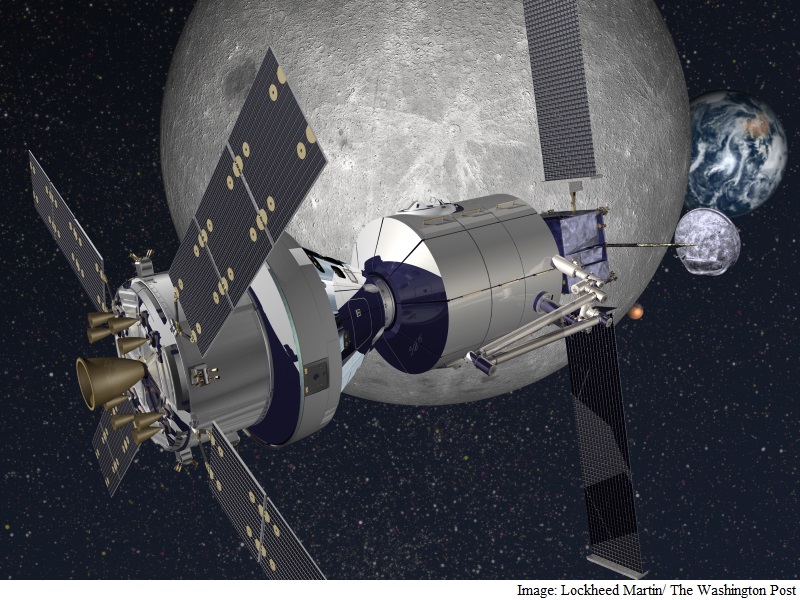- Home
- Science
- Science Features
- Meet Lockheed's Outpost, a Habitat for the 'Proving Ground' of Space
Meet Lockheed's Outpost, a Habitat for the 'Proving Ground' of Space

The habitat would be parked somewhere above the moon where there would be no relatively quick escape back to Earth, as there is on the International Space Station. Rather the astronauts would have to figure out how to survive in deep space on their own - or "stay and fight," said Bill Pratt, the program manager for Lockheed Martin said.
Lockheed, along with several other major contractors, are developing habitats under partnerships with Nasa that would help the agency push further into the cosmos.
Lockheed's proposal, the Outpost, could launch along with the Orion crew capsule it is developing for the agency. The two systems would mate together, giving the crew of four essentially two rooms of space. The idea is to help develop the "next steps in the proving ground on the way to Mars," Pratt said.
Not that the Outpost could go to Mars. Orion can only sustain four astronauts for 21 days on its own. But the idea is to practice launching and staying in deep space in preparation for a Mars journey.
"The moon is an ideal place to practice," Pratt said at the Space Symposium here, where Lockheed is showing off the Outpost. "It's far enough away that you can't just push a button and come home in an emergency. You have to be more self-sufficient and able to troubleshoot problems without having to rely on the ground control."
But much of the plan in is still in the conceptual stages, existing only in models and an artists' conceptual rendering that can't be missed near the restroom at the convention hall here. The program doesn't have the significant funding it would need to move forward. A specific destination for the Outpost hasn't yet been decided.
And the Space Launch System rocket that would launch Orion, and many of the parts of the Outpost, isn't slated to fly its first test unmanned flight until 2018. The first manned mission of the SLS and Orion won't be until 2021 at the earliest and could possibly be delayed until 2023.
Lockheed's Outpost is just one of the options Nasa is considering under what it calls its NextSTEP program. Orbital ATK, Boeing, and Bigelow Aerospace also are part of the public-private partnership. Bigelow's BEAM habitat was recently flown to the space station, where it should soon be attached and inflated. As part of the program, Nasa is also working with industry to develop advancements in propulsion and small satellites.
Unlike Bigelow's collapsible habitat, which is made of a Kevlar-like material that is inflated with air, Lockheed's Outpost is a fixed metal structure that looks like a barrel. It would have a propulsion module that would allow it to maneuver in space. In Lockheed's plan, Orion would ferry the astronauts to the habitat. The Outpost would have sleeping bags that would possibly hang from bungee cords. Or the crew could also sleep in Orion, which has a galley and advanced life support system.
It also could be used as a shelter to protect astronauts in the case of high radiation events.
© 2016 The Washington Post
Get your daily dose of tech news, reviews, and insights, in under 80 characters on Gadgets 360 Turbo. Connect with fellow tech lovers on our Forum. Follow us on X, Facebook, WhatsApp, Threads and Google News for instant updates. Catch all the action on our YouTube channel.
Related Stories
- Samsung Galaxy Unpacked 2025
- ChatGPT
- Redmi Note 14 Pro+
- iPhone 16
- Apple Vision Pro
- Oneplus 12
- OnePlus Nord CE 3 Lite 5G
- iPhone 13
- Xiaomi 14 Pro
- Oppo Find N3
- Tecno Spark Go (2023)
- Realme V30
- Best Phones Under 25000
- Samsung Galaxy S24 Series
- Cryptocurrency
- iQoo 12
- Samsung Galaxy S24 Ultra
- Giottus
- Samsung Galaxy Z Flip 5
- Apple 'Scary Fast'
- Housefull 5
- GoPro Hero 12 Black Review
- Invincible Season 2
- JioGlass
- HD Ready TV
- Laptop Under 50000
- Smartwatch Under 10000
- Latest Mobile Phones
- Compare Phones
- Realme P4x 5G
- OnePlus Ace 6T
- OPPO A6x 5G
- Samsung Galaxy Z TriFold
- Poco F8 Ultra
- Poco F8 Pro
- Huawei Mate 80 RS Master Edition
- Huawei Mate 80 Pro Max
- Asus ProArt P16
- MacBook Pro 14-inch (M5, 2025)
- Poco Pad M1
- Poco Pad X1
- Just Corseca Skywatch Pro
- Honor Watch X5
- Acerpure Nitro Z Series 100-inch QLED TV
- Samsung 43 Inch LED Ultra HD (4K) Smart TV (UA43UE81AFULXL)
- Asus ROG Ally
- Nintendo Switch Lite
- Haier 1.6 Ton 5 Star Inverter Split AC (HSU19G-MZAID5BN-INV)
- Haier 1.6 Ton 5 Star Inverter Split AC (HSU19G-MZAIM5BN-INV)

















